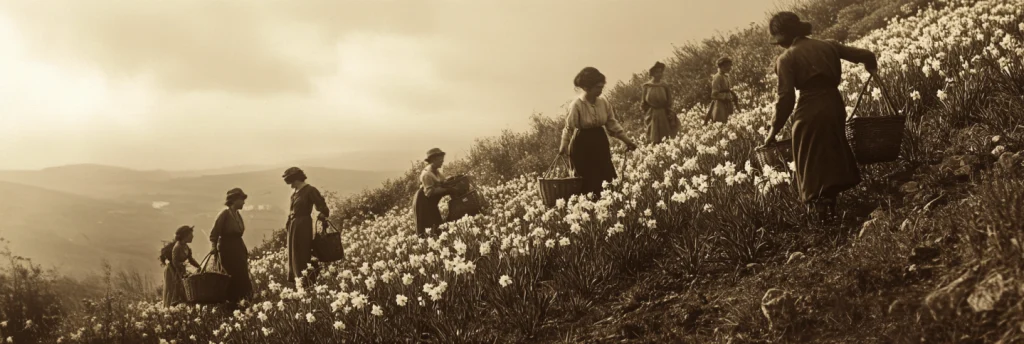Our beautiful Tamar Valley, straddling the border between Devon and Cornwall, is a region steeped in agricultural tradition, with its history of flower and fruit cultivation tracing back to the late 1700s. The valley’s unique geographical and climatic conditions have made it an ideal place for these pursuits, shaping its landscape and economy over the centuries.
Here in the Upper Tamar Valley, local land is predominately used for pasture and arable crops. However, down river from us where the valley becomes steeper reveals one of the valley’s greatest advantages: its southern-facing slopes, which capture ample sunlight and warm up quickly. These slopes are also shielded from harsh northeast winds, creating a microclimate that is markedly milder than many other regions in the UK. This gentle climate, coupled with ample rainfall, provides a prolonged growing season, giving farmers and gardeners a significant advantage in cultivating a variety of crops.
Historically, these conditions have made the Tamar Valley particularly suited for the growing of flowers and fruit. By the late 18th century, the area was already renowned for its orchards and ornamental gardens, with local families and small cooperatives leading the way in these ventures. The valley’s reputation for horticultural excellence grew rapidly as transportation links like railways and steamships expanded, enabling local produce to reach urban markets with ease.
The 19th century saw a boom in the flower industry, especially in the cultivation of daffodils, which became a significant economic contributor to the area. The Tamar Valley’s daffodils were prized for their early blooming, spurred by the favourable local climate, they were transported down the railway to Plymouth and shipped in large quantities across the country. Alongside daffodils, the valley also became known for other floral varieties such as hyacinths and tulips, which flourished under the care of skilled horticulturists who took full advantage of the valley’s ideal growing conditions.
In addition to flowers, the Tamar Valley was also a hub for fruit production, particularly soft fruits like strawberries and cherries, as well as early vegetables such as new potatoes and cauliflowers. These crops benefitted from the same climatic advantages that boosted the flower industry, enabling farmers to market their produce as early season goods at premium prices.
Throughout the 20th century, despite challenges such as the world wars and changing agricultural practices, the tradition of market gardening persisted in the Tamar Valley. The post-war era saw a resurgence in the popularity of both locally grown flowers and fruits as consumers began to value freshness and quality. Today, the legacy of flower and fruit cultivation continues to define the Tamar Valley. Modern growers are blending traditional techniques with sustainable practices to meet contemporary demands while preserving the valley’s natural beauty and horticultural heritage.
Efforts by organisations such as the Tamar Valley Area of Outstanding Natural Beauty (AONB) help protect and promote the area’s agricultural traditions, ensuring that the rich history of flower and fruit growing not only remains a cornerstone of local identity but also continues to thrive and adapt in the modern age. The Tamar Valley’s blossoming fields stand as a testament to the region’s enduring appeal and the harmony between its natural assets and agricultural prowess.
If you would like to explore the beautiful botany of our area, why not stay in our cottages, surrounded by two acres of our own gardens. Click the menu to browse our accomodation.

